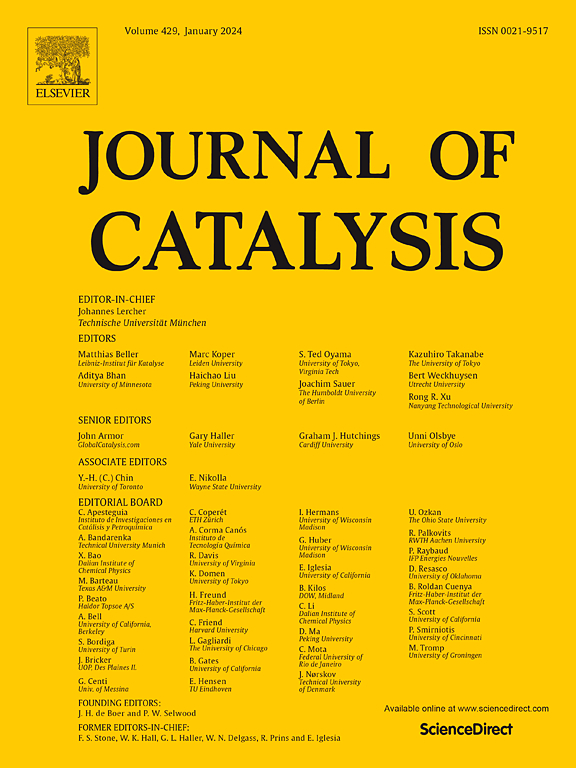揭示了CuCo/NC(由ZIF-67驱动的NC)的纳米/电子结构与其糠醛选择性加氢催化性能之间的内在关系
IF 6.5
1区 化学
Q2 CHEMISTRY, PHYSICAL
引用次数: 0
摘要
本文采用水热法制备了沸石型吡唑酸骨架-67 (ZIF-67),然后在900 ℃的N2中进行热处理,得到了碳掺杂氮(NC)负载钴。采用电替换法制备了Cu和Co负载不同(Cu/Co质量比不同)的CuCo/NC双金属催化剂。通过像差校正扫描透射电子显微镜(AC-STEM)和原位XPS等表征结果证明,所合成的CuCo/NC双金属催化剂的纳米结构是Cu相关物质以单原子和簇共存的形式被支撑在Co纳米颗粒上,然后再支撑在NC上,并且Cu-、Co -和n相关物质之间存在协同效应。在温和的反应条件下(3.0 MPa H2, 100 °C, 6 h),制备的CuCo/ cnc -2 (Cu-9.6 wt%, Co-29.7 wt%)催化剂具有显著的催化活性,糠醛(FF)转化率为51.3% %,糠醇(FA)选择性为97.6% %。此外,密度泛函理论计算进一步证明Cu和Co形成电子协同效应(电子从Co向Cu转移)。一方面,Cu的引入可以显著降低氢解离所需的能量。CuCo/NC-2催化氢解离所需能量仅为0.003 eV,远低于Co/NC催化氢解离所需能量0.382 eV,因此活性氢更容易参与加氢反应。另一方面,CuCo/NC对FF加氢反应具有较低的活化能,使反应更容易进行。CuCo/NC上羰基加氢两步反应所需活化能分别为1.657 eV和1.245 eV,而Co/NC则分别为2.410 eV和2.405 eV。这两个方面对提高CuCo/NC对FF加氢的催化性能(活性和对FA的选择性)起着至关重要的作用。本文章由计算机程序翻译,如有差异,请以英文原文为准。


Revealing the intrinsic relationship between nano/electronic structure of CuCo/NC (NC drived from ZIF-67) and their catalytic performance for furfural selective hydrogenation
In this work, zeolitic imidazolate framework-67 (ZIF-67) is prepared by the hydrothermal method, and then carbon doping with nitrogen (NC)-supported cobalt is gained by the thermal treatment in N2 at 900 °C. The CuCo/NC bimetallic catalysts with different Cu and Co loadings (various Cu/Co mass ratios) are obtained by the galvanic replacement method. A series of characterization results (such as aberration-corrected scanning transmission electron microscopy (AC-STEM) and in-situ XPS) could prove that the nanostructure of the as-synthesized CuCo/NC bimetallic catalysts is that Cu-related species in the form of co-existence of single atoms and clusters is supported on the Co nanoparticles then on NC, and there is a synergy effect among Cu-, Co–, and N-related species. The CuCo/NC-2 (Cu-9.6 wt%, Co-29.7 wt%) catalyst prepared without noble metals demonstrated remarkable catalytic activity under mild reaction conditions (3.0 MPa H2, 100 °C, 6 h), achieving 51.3 % furfural (FF) conversion and 97.6 % furfuryl alcohol (FA) selectivity. In addition, density functional theory calculations further prove that Cu and Co form an electronic synergistic effect (electrons transferring from Co to Cu). On one hand, the introduction of Cu could significantly reduce the energy required for hydrogen dissociation. The energy required for hydrogen dissociation on CuCo/NC-2 is only 0.003 eV, much lower than the 0.382 eV required for Co/NC, so the active hydrogen species much more easily participate in the hydrogenation reaction. On the other hand, CuCo/NC has lower activation energy for the FF hydrogenation reaction, making the reaction easier to proceed. The activation energies required for the two-step reaction of adding H to the carbonyl group over CuCo/NC are only 1.657 eV and 1.245 eV, while Co/NC requires 2.410 eV and 2.405 eV, respectively. These two aspects play a crucial role in enhancing the catalytic performance (activity and selectivity to FA) of CuCo/NC for FF hydrogenation.
求助全文
通过发布文献求助,成功后即可免费获取论文全文。
去求助
来源期刊

Journal of Catalysis
工程技术-工程:化工
CiteScore
12.30
自引率
5.50%
发文量
447
审稿时长
31 days
期刊介绍:
The Journal of Catalysis publishes scholarly articles on both heterogeneous and homogeneous catalysis, covering a wide range of chemical transformations. These include various types of catalysis, such as those mediated by photons, plasmons, and electrons. The focus of the studies is to understand the relationship between catalytic function and the underlying chemical properties of surfaces and metal complexes.
The articles in the journal offer innovative concepts and explore the synthesis and kinetics of inorganic solids and homogeneous complexes. Furthermore, they discuss spectroscopic techniques for characterizing catalysts, investigate the interaction of probes and reacting species with catalysts, and employ theoretical methods.
The research presented in the journal should have direct relevance to the field of catalytic processes, addressing either fundamental aspects or applications of catalysis.
 求助内容:
求助内容: 应助结果提醒方式:
应助结果提醒方式:


